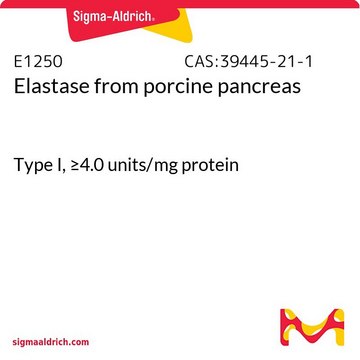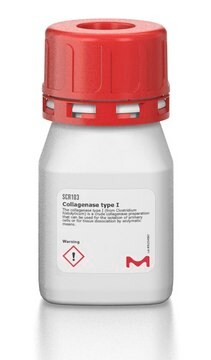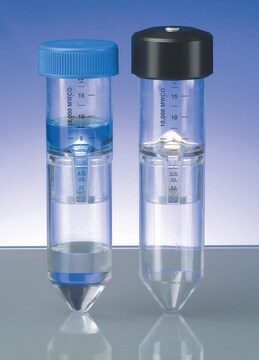Wszystkie zdjęcia(2)
Kluczowe dokumenty
V900891
Collagenase from Clostridium histolyticum
Type I, for general use, Vetec™, reagent grade, powder, ≥125 CDU/mg solid
Synonim(y):
Clostridiopeptidase A
Zaloguj sięWyświetlanie cen organizacyjnych i kontraktowych
About This Item
Polecane produkty
klasa czystości
reagent grade
linia produktu
Vetec™
Formularz
powder
aktywność właściwa
≥125 CDU/mg solid
temp. przechowywania
−20°C
Szukasz podobnych produktów? Odwiedź Przewodnik dotyczący porównywania produktów
Zastosowanie
Collagenase from Clostridium histolyticum may be used for the isolation of cells from many types of animal tissue. VETEC Collagenase Type I has the original balance of collagenase, caseinase, clostripain, and tryptic activities, and is suggested for epithelial, liver, lung and adrenal primary cell isolations.
Działania biochem./fizjol.
Collagenase is activated by four gram atom calcium per mole enzyme. It is inhibited by ethylene glycol-bis(beta-aminoethyl ether) - N, N, N′,N′-tetraacetic acid, beta-mercaptoethanol, glutathione, thioglycolic acid and 8-hydroxyquinoline.
Jakość
Also contains clostripain, nonspecific neutral protease, and tryptic activities.
Definicja jednostki
One collagen digestion unit (CDU) liberates peptides from collagen from bovine achilles tendon equivalent in ninhydrin color to 1.0 μmole of leucine in 5 hours at pH 7.4 at 37 °C in the presence of calcium ions. One FALGPA hydrolysis unit hydrolyzes 1.0 μmole of furylacryloyl-Leu-Gly-Pro-Ala per min at 25°C. One Neutral Protease unit hydrolyzes casein to produce color equivalent to 1.0 μmole of tyrosine per 5 hr at pH 7.5 at 37°C. One Clostripain Unit hydrolyzes 1.0 μmole of BAEE per min at pH 7.6 at 25°C in the presence of DTT.
Informacje prawne
Vetec is a trademark of Merck KGaA, Darmstadt, Germany
Ta strona może zawierać tekst przetłumaczony maszynowo.
Hasło ostrzegawcze
Danger
Zwroty wskazujące rodzaj zagrożenia
Zwroty wskazujące środki ostrożności
Klasyfikacja zagrożeń
Eye Irrit. 2 - Resp. Sens. 1 - Skin Irrit. 2 - STOT SE 3
Organy docelowe
Respiratory system
Kod klasy składowania
11 - Combustible Solids
Klasa zagrożenia wodnego (WGK)
WGK 1
Temperatura zapłonu (°F)
Not applicable
Temperatura zapłonu (°C)
Not applicable
Wybierz jedną z najnowszych wersji:
Masz już ten produkt?
Dokumenty związane z niedawno zakupionymi produktami zostały zamieszczone w Bibliotece dokumentów.
Klienci oglądali również te produkty
Xiaowu Wang et al.
Frontiers in pharmacology, 12, 731609-731609 (2021-11-23)
The incidence of cardiovascular diseases was significantly increased in postmenopausal women. The protection of estrogen in the cardiovascular system has been further reported for decades. Although menopausal hormone therapy has been used in many clinical trials, the debatable results indicate
Mingle Dou et al.
The Journal of biological chemistry, 295(15), 4937-4949 (2020-03-11)
Mammalian skeletal muscles comprise different types of muscle fibers, and this muscle fiber heterogeneity is generally characterized by the expression of myosin heavy chain (MyHC) isoforms. A switch in MyHC expression leads to muscle fiber-type transition under various physiological and
Haijian Cai et al.
Journal of cardiovascular pharmacology, 80(1), 95-109 (2022-05-06)
Dihydroartemisinin (DHA) is an active form of artemisinin extracted from the traditional Chinese medicine Artemisia annua , which is used to treat malaria. Previous studies have shown that DHA has a therapeutic effect on pulmonary hypertension (PH), but its specific
Bing Zhang et al.
Cell death & disease, 10(7), 520-520 (2019-07-10)
C1q-tumor necrosis factor-related protein-3 (CTRP3) is an adipokine, which exerts protective function in ischemic or diabetic heart injury. However, the role of CTRP3 in cardiac hypertrophy remains unclear. The aim of this study was to investigate the pharmacological effects of
Bing Zhang et al.
Oxidative medicine and cellular longevity, 2020, 9187065-9187065 (2021-01-12)
Mitochondrial unfolding protein response (UPRmt) effectively resists the pathological cardiac hypertrophy and improves the mitochondrial function. However, the specific activation mechanism and drugs that can effectively activate UPRmt in the cardiac muscle are yet to be elucidated. The aim of
Nasz zespół naukowców ma doświadczenie we wszystkich obszarach badań, w tym w naukach przyrodniczych, materiałoznawstwie, syntezie chemicznej, chromatografii, analityce i wielu innych dziedzinach.
Skontaktuj się z zespołem ds. pomocy technicznej










